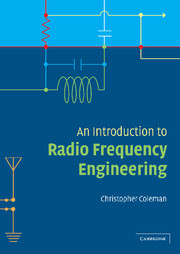Book contents
- Frontmatter
- Contents
- List of figures
- Preface
- Acknowledgements
- 1 Basic concepts
- 2 Frequency selective circuits and matching
- 3 Active devices and amplifiers
- 4 Mixers, modulators and demodulators
- 5 Oscillators and phase locked loops
- 6 Transmission lines and scattering matrices
- 7 Power amplifiers
- 8 Filters
- 9 Electromagnetic waves
- 10 Antennas
- 11 Propagation
- 12 Digital techniques in radio
- Index
10 - Antennas
Published online by Cambridge University Press: 05 June 2012
- Frontmatter
- Contents
- List of figures
- Preface
- Acknowledgements
- 1 Basic concepts
- 2 Frequency selective circuits and matching
- 3 Active devices and amplifiers
- 4 Mixers, modulators and demodulators
- 5 Oscillators and phase locked loops
- 6 Transmission lines and scattering matrices
- 7 Power amplifiers
- 8 Filters
- 9 Electromagnetic waves
- 10 Antennas
- 11 Propagation
- 12 Digital techniques in radio
- Index
Summary
Antennas are the means by which electromagnetic wave energy is fed into, and extracted from, the propagation medium. They are a key element in RF systems and their design and analysis constitutes a very important area of RF engineering. The problems of antenna design are many and varied. Modern spread spectrum systems will require antennas that are capable of operating over a wide range of frequencies. Mobile communications have a requirement for small efficient antennas that radiate over a wide arc. Radar, on the other hand, requires antennas that illuminate only a narrow arc, but can be steered over a wide region. In many systems, the requirements turn out to be conflicting and it is important for the designer to understand the practical constraints in order to achieve the best compromise solution. The present chapter seeks to introduce the most fundamental concepts of antenna engineering and to describe some important varieties of antenna.
Dipole antennas
Broadly speaking, an antenna is a device that transforms wave propagation down a transmission line (a physically narrow channel) into wave propagation through free space (a physically wide channel) and vice versa. If we consider a parallel wire transmission line, we could conceive of opening it out at its end to better couple the waves into free space. The opened out section would then correspond to a dipole antenna. In its unopened state, the transmission line will reflect back to the source almost all of the energy that reaches its end.
- Type
- Chapter
- Information
- An Introduction to Radio Frequency Engineering , pp. 228 - 265Publisher: Cambridge University PressPrint publication year: 2004

